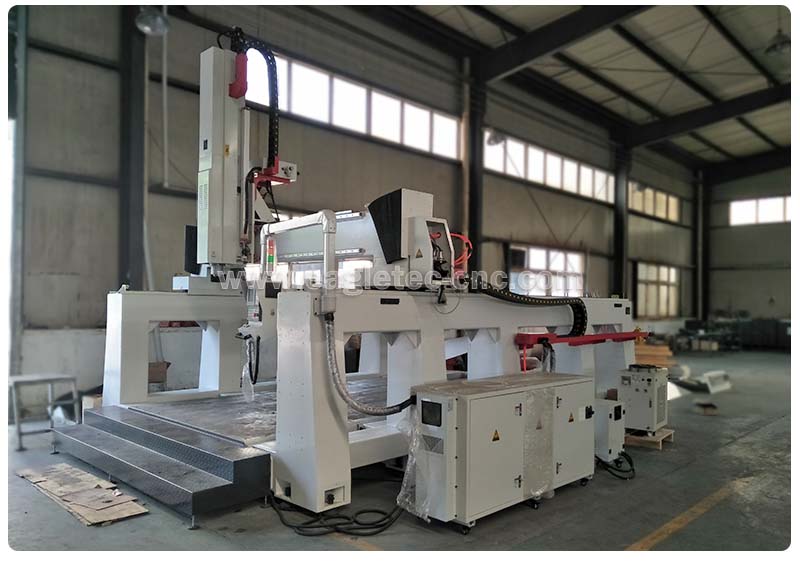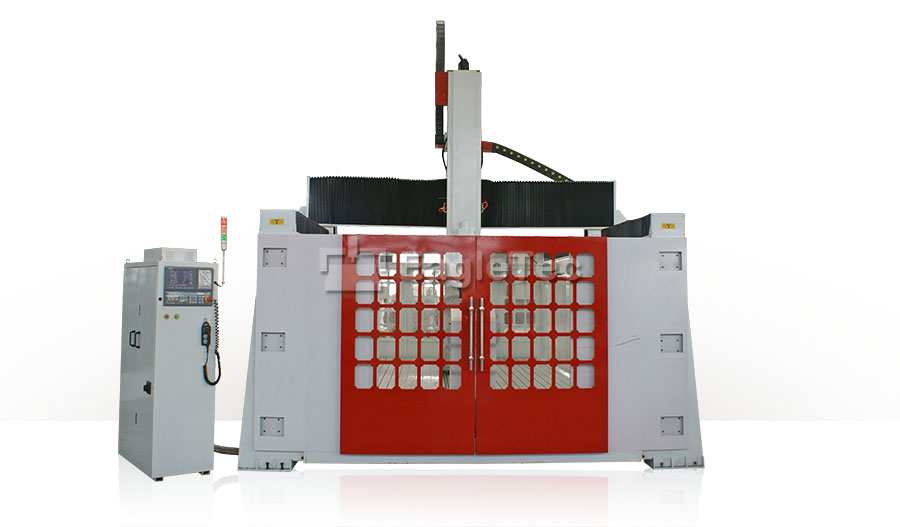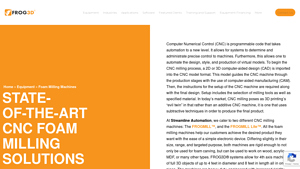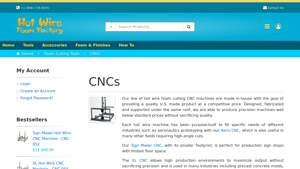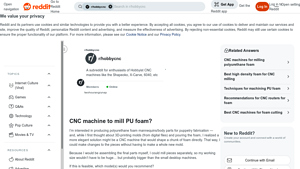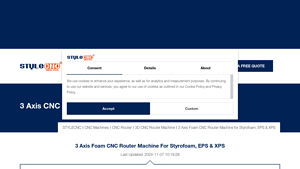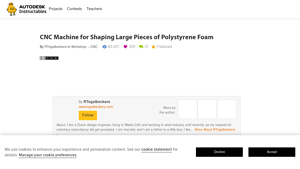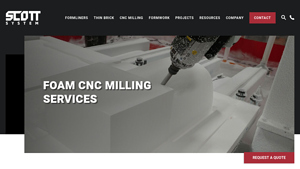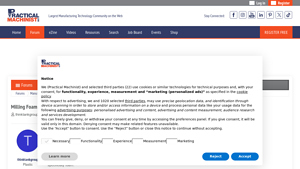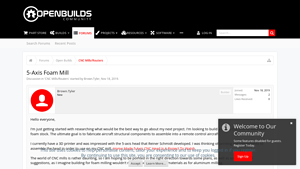Cnc Foam Milling Machine Guide: Type, Cost, Top List…
Introduction: Navigating the Global Market for cnc foam milling machine
In today’s fast-paced manufacturing landscape, sourcing a CNC foam milling machine is critical for businesses aiming to enhance production efficiency and reduce operational costs. However, many international B2B buyers face challenges in identifying the right equipment that meets their specific needs, particularly in regions like Africa, South America, the Middle East, and Europe. This guide is designed to address these challenges by providing a comprehensive overview of the CNC foam milling machine market, focusing on various types of machines, their applications across different industries, and essential factors to consider when vetting suppliers.
From understanding the intricacies of machine specifications to evaluating cost-effectiveness and potential ROI, this guide empowers buyers to make informed purchasing decisions. It delves into the nuances of different CNC foam milling technologies, including hot wire and traditional milling methods, and highlights their suitability for diverse applications—from prototyping in aeronautics to producing custom packaging solutions. Furthermore, it offers insights on the best practices for supplier selection, ensuring that buyers can establish reliable partnerships that align with their manufacturing goals.
By equipping B2B buyers with actionable insights and strategic knowledge, this guide serves as a valuable resource for navigating the global market for CNC foam milling machines, ultimately driving innovation and competitiveness in their respective industries.
Understanding cnc foam milling machine Types and Variations
| Type Name | Key Distinguishing Features | Primary B2B Applications | Brief Pros & Cons for Buyers |
|---|---|---|---|
| FROGMILL™ | Heavy-duty construction, supports 4th axis machining | Prototyping, custom designs, large-scale production | Pros: Versatile, high precision; Cons: Higher initial investment. |
| FROGMILL Lite™ | Compact design, user-friendly interface | Small to medium-scale production, educational use | Pros: Cost-effective, easy setup; Cons: Limited production capacity. |
| Aero CNC | Specialized for high-angle cuts, lightweight design | Aeronautics prototyping, architectural models | Pros: Precision cutting, tailored for specific industries; Cons: Niche application may limit versatility. |
| Sign Maker CNC | Smaller footprint, ideal for limited spaces | Sign making, promotional displays | Pros: Space-efficient, affordable; Cons: Limited material compatibility compared to larger machines. |
| XL Hot Wire CNC | High production capability, optimized for speed | Precast concrete molds, packaging, set design | Pros: Maximizes output, high precision; Cons: Larger size may require more floor space. |
What are the Major Types of CNC Foam Milling Machines?
FROGMILL™ is engineered for heavy-duty applications, capable of 4th axis machining, making it ideal for complex designs and large-scale production. Its robust construction ensures high precision and durability, which is crucial for industries requiring intricate foam models, such as automotive and aerospace. Buyers should consider the upfront investment versus long-term production capabilities, as this machine can significantly enhance operational efficiency.
FROGMILL Lite™ offers a compact and user-friendly option, making it suitable for small to medium-scale production and educational settings. It simplifies the setup process, allowing businesses to quickly adapt to changing production needs. While it presents a cost-effective solution, potential buyers should evaluate whether its limited capacity aligns with their production goals.
Aero CNC is specifically tailored for industries like aeronautics, providing high-angle cutting capabilities essential for prototyping and architectural modeling. This machine’s specialized design makes it a go-to for businesses focused on precision and detail. However, its niche application may restrict its use in broader manufacturing processes, so businesses should assess their specific needs before investing.
Sign Maker CNC is designed for smaller operations, perfect for sign-making and promotional displays. Its compact footprint allows it to fit in limited spaces, making it a popular choice for small businesses. While it is budget-friendly, buyers must note that its capabilities may not extend to more complex foam materials, which could limit future growth.
XL Hot Wire CNC stands out for its high production capability, optimized for speed and efficiency. This machine is particularly beneficial for creating precast concrete molds and packaging solutions. Its ability to handle large volumes without sacrificing precision makes it attractive for companies with high output requirements. However, the larger size may necessitate a more significant investment in floor space, which is a crucial consideration for prospective buyers.
Key Industrial Applications of cnc foam milling machine
| Industry/Sector | Specific Application of CNC Foam Milling Machine | Value/Benefit for the Business | Key Sourcing Considerations for this Application |
|---|---|---|---|
| Aerospace | Prototyping components and models for aircraft design | Reduces lead time for prototype development and testing | Precision requirements, material compatibility, and machine size |
| Signage and Advertising | Creating custom signage and displays | Enhances brand visibility with high-quality, intricate designs | Production volume, machine versatility, and software capabilities |
| Construction | Manufacturing foam molds for precast concrete elements | Improves accuracy and reduces material waste | Durability of tooling, automation features, and production speed |
| Film and Theater | Designing props and set pieces for productions | Streamlines production processes and enhances creativity | Material compatibility, design flexibility, and cost efficiency |
| Packaging | Producing protective packaging and custom foam inserts | Ensures product safety during transit and enhances presentation | Customization options, lead times, and tooling longevity |
How is CNC Foam Milling Used in Aerospace Applications?
In the aerospace sector, CNC foam milling machines are utilized for prototyping components and models essential in aircraft design. This process allows engineers to create precise foam replicas of parts, enabling thorough testing and validation before moving to costly manufacturing stages. The technology helps reduce lead times significantly, which is crucial in a competitive industry where innovation and speed are paramount. International buyers should focus on sourcing machines that offer high precision and are compatible with the specific types of foam used in aerospace applications, ensuring that they meet stringent industry standards.
What are the Benefits of CNC Foam Milling in Signage and Advertising?
CNC foam milling machines play a vital role in the signage and advertising industry by allowing companies to create custom signs and displays with intricate designs. The ability to produce high-quality visuals enhances brand visibility, attracting more customers. Businesses benefit from reduced production time and costs, as CNC machines can automate complex cutting processes. For international buyers, it is essential to consider the machine’s production volume capabilities and the versatility to handle various materials, ensuring they can meet diverse client needs.
How Does CNC Foam Milling Improve Construction Processes?
In construction, CNC foam milling machines are primarily used to manufacture foam molds for precast concrete elements. This application ensures high accuracy in mold creation, which directly translates to better quality in the final concrete products. By optimizing the use of materials and reducing waste, businesses can achieve significant cost savings. Buyers from regions with developing construction markets should prioritize sourcing durable machines that can handle large-scale production while maintaining precision, as this will enhance their operational efficiency.
Why is CNC Foam Milling Important for Film and Theater Production?
CNC foam milling is essential in the film and theater industry for designing props and set pieces. The ability to create lightweight, detailed, and customized items quickly allows production teams to enhance their creative vision while streamlining the production process. This technology reduces manual labor and speeds up the fabrication of complex designs. Buyers should look for machines that offer flexibility in design and material compatibility, as this will enable them to adapt to various production needs and artistic requirements.
How Does CNC Foam Milling Contribute to Effective Packaging Solutions?
In the packaging industry, CNC foam milling machines are employed to produce protective packaging and custom foam inserts tailored to specific products. This ensures that items are securely cushioned during transit, minimizing damage and improving overall presentation. By automating the production of these inserts, businesses can enhance efficiency and reduce labor costs. For international buyers, it’s crucial to evaluate customization options and lead times, as these factors significantly impact their ability to meet diverse customer demands effectively.
3 Common User Pain Points for ‘cnc foam milling machine’ & Their Solutions
Scenario 1: Complicated Setup Processes for CNC Foam Milling Machines
The Problem: Many B2B buyers encounter significant challenges during the setup phase of CNC foam milling machines. The initial installation often requires specialized knowledge of both the machinery and the software involved. In regions such as Africa and South America, where access to technical support may be limited, buyers can find themselves frustrated and unable to commence production. This can lead to costly delays and potential loss of revenue, especially for businesses that rely on quick turnarounds to meet customer demands.
The Solution: To streamline the setup process, buyers should prioritize sourcing machines that offer user-friendly interfaces and comprehensive support packages. Look for CNC foam milling machines that come with detailed installation guides and intuitive software that allows for easy design import and tool selection. Additionally, consider investing in training sessions, either in-person or online, provided by the manufacturer. This will equip your team with the necessary skills to handle the setup independently and reduce reliance on external support. Establishing a relationship with local distributors who can provide ongoing assistance will also mitigate setup challenges in the long run.
Scenario 2: High Operational Costs Due to Inefficiencies
The Problem: Operational inefficiencies can lead to spiraling costs for businesses utilizing CNC foam milling machines. Issues such as excessive material waste, prolonged machining times, and frequent tool replacements can significantly impact a company’s bottom line. For B2B buyers in competitive markets, particularly in the Middle East and Europe, these inefficiencies can hinder their ability to price competitively and meet customer expectations.
The Solution: To combat these inefficiencies, buyers should focus on selecting a CNC foam milling machine with advanced features that enhance precision and reduce waste. Opt for machines equipped with adaptive feed rates and intelligent toolpath algorithms that optimize cutting strategies. Regular maintenance schedules should be implemented to ensure machines operate at peak performance, thereby extending tool life and minimizing unplanned downtime. Additionally, consider integrating software solutions that analyze production data, allowing you to identify trends and areas for improvement. This data-driven approach will enable you to refine your processes continually and maintain a competitive edge.
Scenario 3: Limited Material Versatility and Application Knowledge
The Problem: Many B2B buyers struggle with the limited versatility of CNC foam milling machines, particularly when it comes to working with various materials. While some machines are designed exclusively for foam, buyers may want to expand their capabilities to include materials such as wood, acrylic, or composites. This limitation can restrict production opportunities and affect the overall profitability of their operations.
The Solution: To maximize the versatility of CNC foam milling machines, buyers should look for models that can accommodate a wide range of materials without requiring significant modifications. When sourcing a machine, inquire about its compatibility with various cutting tools and attachments designed for different materials. Furthermore, investing in training for your operators on how to program the machine for diverse applications will expand your production capabilities. Collaborating with suppliers who offer materials and tooling for multiple applications can also provide valuable insights into best practices and innovative uses for your CNC milling machine, ultimately enhancing your operational flexibility and market reach.
Strategic Material Selection Guide for cnc foam milling machine
What Are the Key Materials Used in CNC Foam Milling Machines?
When selecting materials for CNC foam milling machines, it is crucial to consider their properties, advantages, disadvantages, and suitability for specific applications. This guide analyzes four common materials—Polyurethane Foam, Expanded Polystyrene (EPS), Extruded Polystyrene (XPS), and Polyethylene Foam—providing insights tailored for international B2B buyers.
How Does Polyurethane Foam Perform in CNC Milling Applications?
Polyurethane foam (PU foam) is widely used in various industries due to its versatility and performance characteristics. It offers excellent cushioning properties, is lightweight, and has good thermal insulation capabilities. PU foam can withstand moderate temperatures, making it suitable for applications such as packaging and prototyping.
Pros: The material is relatively cost-effective and easy to machine, allowing for intricate designs and shapes. Its adaptability makes it suitable for a range of applications, from automotive to aerospace.
Cons: However, PU foam can be prone to degradation when exposed to UV light and certain chemicals. Its mechanical properties can vary significantly based on density, which may affect product consistency.
Impact on Application: PU foam is particularly effective for creating protective packaging solutions, ensuring that products remain intact during transportation.
Considerations for International Buyers: Compliance with ASTM standards for foam performance is essential. Buyers should also consider local preferences, particularly in regions like Africa and South America, where environmental factors may influence material choice.
What Are the Benefits of Using Expanded Polystyrene (EPS) in CNC Milling?
Expanded Polystyrene (EPS) is another popular material for CNC foam milling. It is lightweight, provides excellent thermal insulation, and is resistant to moisture. EPS is commonly used in construction, packaging, and as a protective material for delicate items.
Pros: Its low cost and ease of machining make EPS an attractive option for high-volume production. The material’s buoyancy also allows it to be used in marine applications.
Cons: On the downside, EPS is less durable than other materials and can be easily damaged by physical impact. Additionally, it is not suitable for high-temperature applications.
Impact on Application: EPS is ideal for creating molds and prototypes, particularly in the construction and packaging industries.
Considerations for International Buyers: Buyers should ensure compliance with local building codes and environmental regulations, particularly in Europe, where sustainability is increasingly prioritized.
How Does Extruded Polystyrene (XPS) Compare in CNC Foam Milling?
Extruded Polystyrene (XPS) is known for its superior moisture resistance and structural integrity compared to EPS. It is often utilized in applications requiring insulation, such as in building foundations and roofing.
Pros: XPS offers excellent compressive strength and thermal performance, making it suitable for demanding applications. Its smooth surface finish allows for high-quality milling results.
Cons: The primary drawback of XPS is its higher cost compared to EPS and PU foam. Additionally, it can be more challenging to machine due to its density.
Impact on Application: XPS is particularly beneficial in construction and insulation applications, where durability and thermal resistance are critical.
Considerations for International Buyers: Buyers should be aware of local insulation standards, such as those set by DIN in Europe, to ensure compliance.
What Role Does Polyethylene Foam Play in CNC Milling?
Polyethylene foam is a versatile material known for its excellent cushioning properties and chemical resistance. It is commonly used in packaging, sports equipment, and automotive applications.
Pros: The material is lightweight, durable, and resistant to moisture and chemicals. It can be easily machined to create custom shapes and sizes.
Cons: However, polyethylene foam can be more expensive than other foam types, and its performance can vary based on density and formulation.
Impact on Application: Polyethylene foam is ideal for protective packaging, ensuring that products are safeguarded during transit.
Considerations for International Buyers: Buyers should ensure that the foam meets international shipping standards and consider local preferences regarding material sustainability.
Summary Table of Material Selection for CNC Foam Milling Machines
| Material | Typical Use Case for cnc foam milling machine | Key Advantage | Key Disadvantage/Limitation | Relative Cost (Low/Med/High) |
|---|---|---|---|---|
| Polyurethane Foam | Packaging, prototyping | Excellent cushioning properties | Prone to UV degradation | Medium |
| Expanded Polystyrene (EPS) | Molds, prototypes | Low cost, easy to machine | Less durable, sensitive to impact | Low |
| Extruded Polystyrene (XPS) | Insulation in construction | Superior moisture resistance | Higher cost, harder to machine | High |
| Polyethylene Foam | Protective packaging | Lightweight and durable | More expensive, variable performance | Medium |
This strategic material selection guide provides international B2B buyers with valuable insights into the properties and applications of different materials used in CNC foam milling. By understanding these factors, buyers can make informed decisions that align with their specific manufacturing needs and compliance requirements.
In-depth Look: Manufacturing Processes and Quality Assurance for cnc foam milling machine
What Are the Main Stages of Manufacturing a CNC Foam Milling Machine?
The manufacturing process for CNC foam milling machines typically involves several key stages: material preparation, forming, assembly, and finishing. Understanding these stages is crucial for B2B buyers seeking reliable suppliers.
Material Preparation
The first stage begins with sourcing high-quality materials, which often include aluminum, steel, and specialized plastics. The choice of materials significantly impacts the durability and performance of the CNC machine. For instance, high-grade aluminum is preferred for lightweight yet robust frames, while steel is often used for components that require additional strength. Quality assurance begins at this stage, with suppliers expected to provide material certificates to verify compliance with international standards.
Forming Techniques: How Are CNC Foam Milling Machines Created?
Once materials are prepared, they undergo various forming techniques. This may include CNC machining, where precision cutting tools shape the components according to CAD designs. Advanced manufacturers utilize 5-axis machining capabilities to achieve complex geometries, ensuring that every part fits together seamlessly.
In addition to traditional machining, some manufacturers may employ additive manufacturing techniques for specific components, enhancing flexibility and reducing waste. These processes must be closely monitored to ensure adherence to design specifications, contributing to overall machine accuracy.
What Is Involved in the Assembly Process?
After forming, the assembly of the CNC foam milling machine takes place. This stage requires highly skilled technicians who ensure that each component is correctly aligned and securely fastened. Key aspects of assembly include the installation of the CNC control system, motors, and any necessary electronic components.
Quality checkpoints during assembly, such as in-process quality control (IPQC), are essential. These checkpoints verify that each component meets required tolerances and specifications before moving to the next stage. This proactive approach helps to minimize defects and ensures that the final product operates efficiently.
What Finishing Techniques Are Used in CNC Foam Milling Machines?
Finishing processes enhance the aesthetics and functionality of the CNC foam milling machines. Techniques may include anodizing or powder coating metal components, which not only improve appearance but also provide corrosion resistance. Additionally, precision testing of the machine’s operational capabilities is conducted at this stage, often using software simulations to ensure that the CNC machine performs as intended under various conditions.
What Quality Assurance Measures Are Essential for CNC Foam Milling Machines?
Quality assurance (QA) is a critical component in the production of CNC foam milling machines. International and industry-specific standards guide QA processes, ensuring that manufacturers produce reliable and safe equipment.
Which International Standards Should B2B Buyers Consider?
ISO 9001 is the most widely recognized quality management standard, ensuring that manufacturers maintain effective processes and continuous improvement. Compliance with ISO standards is often a prerequisite for international buyers, as it demonstrates a commitment to quality and customer satisfaction.
In addition to ISO 9001, other certifications may be relevant depending on the machine’s intended application. For instance, CE marking signifies compliance with European safety, health, and environmental protection standards, while API certification may be necessary for machines used in the oil and gas sector.
What Are the Key Quality Control Checkpoints?
Quality control checkpoints are integral throughout the manufacturing process. Key checkpoints include:
- Incoming Quality Control (IQC): Verification of incoming materials against specifications.
- In-Process Quality Control (IPQC): Monitoring of production processes to ensure compliance with design specifications.
- Final Quality Control (FQC): Comprehensive testing of the completed CNC foam milling machine, including operational tests and safety inspections.
These checkpoints help identify and rectify potential issues early in the production process, reducing the risk of defects in the final product.
How Can B2B Buyers Verify Supplier Quality Control?
B2B buyers must adopt a proactive approach to verify the quality control processes of their suppliers. Here are some effective strategies:
What Should Buyers Look for in Supplier Audits and Reports?
- Supplier Audits: Conducting regular audits of potential suppliers can provide valuable insights into their quality management practices. Buyers should look for evidence of adherence to ISO standards, as well as documentation of any internal quality control processes.
- Quality Reports: Requesting detailed quality reports can help buyers understand a supplier’s defect rates, compliance with standards, and any corrective actions taken in response to quality issues.
Should Buyers Consider Third-Party Inspections?
Engaging third-party inspection services can be beneficial for B2B buyers, particularly when purchasing high-value equipment like CNC foam milling machines. Independent inspectors can verify compliance with specifications and standards, providing an additional layer of assurance.
What Are the Quality Control Nuances for International B2B Buyers?
International buyers, particularly those from regions like Africa, South America, the Middle East, and Europe, should be aware of specific nuances in quality control. Factors such as regional regulations, import/export standards, and language barriers can impact the procurement process.
How Do Regional Regulations Affect Quality Assurance?
Each region may have unique regulations governing machinery safety and performance. For instance, buyers in Europe must ensure compliance with CE marking requirements, while buyers in the Middle East may need to adhere to GSO standards. Understanding these requirements is essential for successful procurement.
What Role Does Communication Play in Ensuring Quality?
Effective communication is key in international transactions. Buyers should establish clear lines of communication with suppliers, including language preferences and time zone considerations. This facilitates better understanding of quality expectations and allows for timely resolution of any issues that may arise during the manufacturing process.
By thoroughly understanding the manufacturing processes and quality assurance measures associated with CNC foam milling machines, B2B buyers can make informed decisions that enhance their procurement strategies and ensure the acquisition of high-quality machinery.
Practical Sourcing Guide: A Step-by-Step Checklist for ‘cnc foam milling machine’
Introduction
This guide provides a comprehensive checklist for B2B buyers interested in procuring CNC foam milling machines. It aims to streamline the sourcing process by outlining essential steps that ensure you select the right equipment and supplier for your specific needs. Whether you are in Africa, South America, the Middle East, or Europe, this checklist will help you navigate the complexities of sourcing CNC machines effectively.
Step 1: Define Your Technical Specifications
Clearly outline your operational requirements, including the types of foam you will be milling, the dimensions of your projects, and the desired precision levels. This step is crucial as it sets the foundation for your purchasing decision, ensuring that the machine’s capabilities align with your production needs. Consider factors like:
– Material Compatibility: Ensure the machine can handle various foam types.
– Size Requirements: Determine the maximum dimensions of the materials you will be processing.
Step 2: Research and Identify Potential Suppliers
Conduct thorough research to compile a list of reputable suppliers that specialize in CNC foam milling machines. Look for companies with a proven track record in your industry and region. This step is vital as it helps you narrow down your options to those who can meet your specific needs. Key points to consider include:
– Supplier Experience: Focus on suppliers with years of expertise in CNC technology.
– Product Range: Ensure they offer a variety of machines suitable for different applications.
Step 3: Evaluate Supplier Certifications
Before finalizing your supplier, verify their certifications and compliance with international standards. This is important as it reflects the quality and reliability of the machines they offer. Look for certifications such as:
– ISO Certification: Indicates adherence to quality management standards.
– Safety Certifications: Ensure the machines meet safety regulations pertinent to your industry.
Step 4: Request Detailed Product Information
Once you have shortlisted potential suppliers, request detailed product specifications and catalogs. This will allow you to compare features, capabilities, and pricing. Pay attention to:
– Technical Documentation: Check for user manuals, maintenance guides, and technical support options.
– Software Compatibility: Ensure the machine can integrate with your existing design and production software.
Step 5: Consider Total Cost of Ownership
When evaluating options, consider not just the initial purchase price but the total cost of ownership over the machine’s lifespan. This includes maintenance, operational costs, and potential upgrades. Important factors to assess are:
– Energy Efficiency: Look for machines that consume less power without compromising performance.
– Maintenance Requirements: Consider the availability of spare parts and service support in your region.
Step 6: Seek Customer Testimonials and Case Studies
Request references from the supplier and seek out customer testimonials or case studies from similar industries. This provides insight into the reliability and performance of the machines you are considering. Focus on:
– User Experiences: Understand how the machine has performed in real-world applications.
– Support and Service: Gauge the level of customer service provided post-purchase.
Step 7: Negotiate Terms and Finalize Your Purchase
Once you’ve evaluated the options, engage in negotiations to secure the best terms. This step is crucial to ensure you receive value for your investment. Key negotiation points include:
– Payment Terms: Discuss flexible payment options that suit your cash flow.
– Warranty and Support: Ensure that you have adequate warranty coverage and ongoing technical support.
By following this checklist, you can make an informed decision when sourcing CNC foam milling machines, ultimately enhancing your operational efficiency and product quality.
Comprehensive Cost and Pricing Analysis for cnc foam milling machine Sourcing
What Are the Key Cost Components Involved in Sourcing CNC Foam Milling Machines?
When sourcing CNC foam milling machines, understanding the cost structure is crucial for international B2B buyers. The total cost can be broken down into several key components:
-
Materials: The primary material used in CNC foam milling machines is high-grade metal for the frame and components, along with specialized tooling for cutting foam and other materials. The choice of materials can significantly affect the durability and performance of the machine.
-
Labor: Labor costs encompass the wages of skilled technicians involved in the design, manufacturing, and assembly of the machines. In regions with higher labor costs, such as Europe, you may find that the final product price reflects these expenses.
-
Manufacturing Overhead: This includes costs related to factory operations, utilities, and indirect labor. Manufacturers often allocate a percentage of overhead costs to each machine produced, influencing the final pricing.
-
Tooling: Specialized cutting tools, which can wear out over time, are essential for efficient milling. The initial investment in high-quality tooling can enhance performance and reduce long-term costs.
-
Quality Control (QC): Implementing rigorous QC processes ensures that machines meet industry standards and customer specifications. This adds an additional layer of cost but is crucial for maintaining quality and reliability.
-
Logistics: Shipping costs can vary based on the origin of the machine and destination, particularly for international buyers. Factors such as freight forwarding, customs duties, and insurance should be considered in the overall cost.
-
Margin: Suppliers typically include a margin to cover profit and risk. This margin can vary based on the supplier’s market position and the competitive landscape.
How Do Price Influencers Impact CNC Foam Milling Machine Costs?
Several factors can influence the pricing of CNC foam milling machines, particularly for international buyers:
-
Volume/MOQ (Minimum Order Quantity): Bulk purchases often lead to discounts. Negotiating a higher quantity can provide significant savings, especially for businesses looking to scale operations.
-
Specifications and Customization: Custom features or specific technical requirements can increase costs. Buyers should assess whether these customizations are essential or if standard models suffice.
-
Materials: The choice of materials can impact cost. Higher-quality materials may lead to increased durability and performance but will also elevate the initial purchase price.
-
Quality and Certifications: Machines that meet international quality standards or possess specific certifications may command a higher price. This is particularly relevant for industries requiring stringent compliance.
-
Supplier Factors: The supplier’s reputation, experience, and location can affect pricing. Established suppliers with a history of reliability may charge more, but the investment often pays off in terms of performance and support.
-
Incoterms: Understanding Incoterms (International Commercial Terms) is vital for international transactions. They define responsibilities for shipping, insurance, and customs, which can influence overall costs.
What Tips Can Help Buyers Navigate CNC Foam Milling Machine Pricing?
For international B2B buyers, particularly from regions like Africa, South America, the Middle East, and Europe, navigating the pricing landscape can be complex. Here are several actionable tips:
-
Negotiation: Engage in discussions with suppliers to explore volume discounts or flexible payment terms. Establishing a strong relationship can also lead to better pricing.
-
Cost-Efficiency: Consider the Total Cost of Ownership (TCO), which includes not just the purchase price but also maintenance, operational costs, and potential downtime. A slightly higher upfront cost may lead to lower operational costs over time.
-
Research and Compare: Conduct thorough research on various suppliers and their offerings. Comparing specifications, pricing, and support services can help you make an informed decision.
-
Understand Regional Variations: Be aware of regional pricing differences influenced by local market conditions, currency fluctuations, and trade regulations. This knowledge can aid in negotiating better deals.
-
Seek Expert Advice: If possible, consult industry experts or peers who have experience with CNC foam milling machines. Their insights can provide valuable guidance in the sourcing process.
Conclusion
While the initial cost of sourcing a CNC foam milling machine can be significant, understanding the various components and influencers of pricing can help international B2B buyers make strategic purchasing decisions. By leveraging negotiation strategies and considering the total cost of ownership, companies can ensure they select the right equipment for their operational needs, ultimately leading to enhanced productivity and profitability.
Alternatives Analysis: Comparing cnc foam milling machine With Other Solutions
Understanding Alternatives in CNC Foam Processing
In the realm of foam processing, the choice of technology can significantly impact production efficiency, cost-effectiveness, and product quality. While CNC foam milling machines are widely recognized for their precision and versatility, several alternative solutions exist that may better suit specific operational needs. This analysis compares CNC foam milling machines against hot wire foam cutting machines and traditional manual foam cutting techniques, providing insights that can guide B2B buyers in making informed decisions.
Comparison Table
| Comparison Aspect | CNC Foam Milling Machine | Hot Wire Foam Cutting Machine | Manual Foam Cutting Techniques |
|---|---|---|---|
| Performance | High precision and detail; capable of complex shapes and 3D designs | Good for straight cuts; less precision for complex shapes | Variable precision; dependent on operator skill |
| Cost | Higher initial investment; lower operational costs due to efficiency | Moderate initial cost; lower than CNC but may require more labor | Lowest upfront cost; labor-intensive and less efficient |
| Ease of Implementation | Requires skilled operators and software integration | Easier setup; less technical knowledge required | Simple tools; no technical skills needed |
| Maintenance | Requires regular maintenance and software updates | Lower maintenance; fewer moving parts | Minimal maintenance; tool replacement as needed |
| Best Use Case | Complex designs, large production runs, and diverse materials | Sign-making, architectural modeling, and prototyping | Low-volume projects or custom shapes without heavy machinery |
Analyzing Hot Wire Foam Cutting Machines
Hot wire foam cutting machines are designed specifically for cutting foam using a heated wire. This method excels in producing straight cuts and is particularly effective in applications such as sign-making and architectural modeling. The primary advantages of hot wire machines include their lower cost compared to CNC machines and ease of operation, making them accessible for businesses with limited technical expertise. However, they fall short in delivering the precision and complexity that CNC milling can offer, limiting their use in more intricate designs.
Exploring Manual Foam Cutting Techniques
Manual foam cutting techniques involve using basic tools such as knives or hot wire cutters operated by hand. This method is the most cost-effective, requiring minimal investment in equipment. While it allows for flexibility and creativity, the quality of the final product heavily relies on the skill of the operator. Manual cutting is best suited for low-volume projects or custom shapes where precision is not the primary concern. However, the labor-intensive nature of this approach can lead to increased production times and inconsistent quality.
Making the Right Choice for Your Business
When selecting a foam processing solution, B2B buyers should consider their specific operational needs, budget constraints, and the complexity of the products they intend to produce. CNC foam milling machines offer unmatched precision and versatility, making them ideal for large-scale operations requiring intricate designs. In contrast, hot wire foam cutting machines present a more affordable option for businesses focused on simpler applications, while manual techniques may suffice for low-volume or custom work. Ultimately, the best choice will align with the buyer’s production goals, resource availability, and the desired quality of the final product.
Essential Technical Properties and Trade Terminology for cnc foam milling machine
What Are the Key Technical Properties of CNC Foam Milling Machines?
Understanding the technical specifications of CNC foam milling machines is crucial for businesses looking to invest in this technology. Here are some essential properties to consider:
-
Material Compatibility
CNC foam milling machines are designed to work with various materials, including polyurethane (PU) foam, expanded polystyrene (EPS), and other composites. The machine’s capability to mill different materials allows companies to diversify their product offerings, catering to industries such as aerospace, automotive, and entertainment. -
Precision and Tolerances
Precision is a hallmark of CNC technology. Typical tolerances for CNC foam milling machines range from ±0.1 mm to ±0.5 mm. This precision ensures that parts fit together seamlessly, which is vital for applications in prototyping and production where accuracy can significantly impact the final product quality and functionality. -
Spindle Speed and Power
The spindle speed, often measured in revolutions per minute (RPM), is crucial for determining the efficiency of the milling process. High-speed spindles (up to 60,000 RPM) enable faster cutting, reducing production time and costs. Additionally, the spindle power (typically ranging from 2 kW to 10 kW) affects the machine’s ability to handle dense materials, influencing both performance and longevity. -
Axis Configuration
Most CNC foam milling machines operate with a 3-axis or 5-axis configuration. A 3-axis machine allows for linear movement along the X, Y, and Z axes, while a 5-axis machine enables more complex shapes and angles, making it suitable for intricate designs. This flexibility is essential for companies that require customized solutions in their manufacturing processes. -
Software Integration
CNC foam milling machines are often equipped with advanced software for Computer-Aided Design (CAD) and Computer-Aided Manufacturing (CAM). This software is crucial for importing designs and optimizing the machining process, allowing manufacturers to streamline production and reduce errors, ultimately enhancing operational efficiency. -
Build Quality and Rigidity
The machine’s build quality affects its durability and performance. A robust frame with high rigidity minimizes vibrations during operation, which is vital for maintaining precision. This is particularly important in high-output environments where consistent quality is paramount.
Which Trade Terms Should B2B Buyers Understand for CNC Foam Milling Machines?
Navigating the procurement process for CNC foam milling machines involves understanding specific trade terminology. Here are some essential terms:
-
OEM (Original Equipment Manufacturer)
An OEM refers to a company that produces parts or equipment that may be marketed by another manufacturer. Understanding OEM relationships is crucial for buyers looking for quality assurance and compatibility with existing machinery. -
MOQ (Minimum Order Quantity)
MOQ denotes the smallest number of units a supplier is willing to sell. This term is vital for budget-conscious buyers who need to balance inventory levels with production requirements. Knowing the MOQ can help in negotiating better terms with suppliers. -
RFQ (Request for Quotation)
An RFQ is a document sent to suppliers requesting pricing and terms for specific products. This process allows buyers to compare offers and negotiate better deals, ensuring they receive competitive pricing for their CNC foam milling machines. -
Incoterms (International Commercial Terms)
Incoterms define the responsibilities of buyers and sellers regarding the delivery of goods. Familiarity with these terms helps buyers understand shipping costs, risks, and responsibilities, which is crucial for smooth international transactions. -
Lead Time
Lead time refers to the duration between placing an order and receiving the goods. For manufacturers, understanding lead times is critical for planning production schedules and managing inventory effectively. -
After-Sales Support
This term encompasses the services provided by a supplier after a product is purchased, including installation, maintenance, and training. Strong after-sales support is essential for minimizing downtime and ensuring optimal performance of CNC foam milling machines.
By understanding these technical properties and trade terms, B2B buyers can make informed decisions that enhance their manufacturing capabilities and operational efficiency.
Navigating Market Dynamics and Sourcing Trends in the cnc foam milling machine Sector
What Are the Current Market Dynamics and Key Trends in the CNC Foam Milling Machine Sector?
The CNC foam milling machine sector is experiencing significant growth driven by technological advancements and increasing demand for customized solutions across various industries. The global market is expected to expand due to the rise of automation and the adoption of Computer-Aided Design (CAD) and Computer-Aided Manufacturing (CAM) technologies. B2B buyers from regions like Africa, South America, the Middle East, and Europe are particularly interested in machines that offer versatility, enabling them to work with a range of materials beyond foam, such as wood and acrylic. This adaptability is crucial for industries like aerospace, automotive, and packaging, where precision and customization are paramount.
Emerging trends include the integration of artificial intelligence (AI) and machine learning into CNC systems, enhancing operational efficiency and predictive maintenance capabilities. Moreover, the emphasis on high-speed machining is pushing manufacturers to develop machines that not only reduce production times but also improve accuracy. Buyers are increasingly seeking suppliers that offer comprehensive support and training, ensuring a smooth transition to automated processes. Additionally, the demand for smaller footprint machines is rising, especially in densely populated regions, where space is at a premium.
How Are Sustainability and Ethical Sourcing Addressed in the CNC Foam Milling Machine Market?
Sustainability has become a critical consideration for B2B buyers in the CNC foam milling machine sector. The environmental impact of manufacturing processes, particularly in terms of waste generation and energy consumption, is under scrutiny. Suppliers are increasingly expected to adopt sustainable practices, such as using energy-efficient machines and minimizing waste through optimized cutting strategies.
Ethical sourcing is also gaining prominence. Buyers are looking for manufacturers who can demonstrate a commitment to responsible sourcing of materials and the use of environmentally friendly certifications. Green certifications, such as ISO 14001 for environmental management, can enhance a company’s reputation and appeal to eco-conscious customers. Additionally, the use of recyclable or biodegradable materials in foam production is becoming a significant factor in purchasing decisions, as companies strive to reduce their carbon footprint and improve their sustainability profiles.
What Is the Brief Evolution and History of CNC Foam Milling Machines?
CNC foam milling machines have evolved significantly since their inception. Initially, milling technology was predominantly focused on metals and rigid materials. However, as industries recognized the potential of foam for prototyping and custom applications, manufacturers began to develop specialized CNC machines capable of cutting foam with precision.
The introduction of CAD and CAM software revolutionized the foam milling process, allowing for intricate designs and efficient production workflows. Over the past two decades, advancements in machine technology, such as higher spindle speeds and improved tooling, have further enhanced the capabilities of CNC foam milling machines. Today, these machines are integral to various sectors, from aerospace to entertainment, enabling businesses to create complex shapes and structures that meet modern design requirements.
Frequently Asked Questions (FAQs) for B2B Buyers of cnc foam milling machine
-
How do I choose the right CNC foam milling machine for my business needs?
Selecting the right CNC foam milling machine depends on your specific application, production volume, and budget. Consider factors such as the machine’s precision, the type of foam it can handle, and its compatibility with your existing manufacturing processes. Additionally, evaluate the machine’s size and footprint to ensure it fits your workspace. Research different models and manufacturers, and seek recommendations from industry peers to find a solution that aligns with your operational requirements. -
What is the average cost of a CNC foam milling machine?
The cost of a CNC foam milling machine can vary significantly based on its specifications, capabilities, and brand. On average, prices can range from $9,000 to $30,000 or more, depending on features like size, technology (e.g., hot wire vs. traditional milling), and automation level. It’s essential to compare quotes from multiple suppliers and consider total cost of ownership, including maintenance and operational costs, to make an informed decision. -
What are the key features to look for in a CNC foam milling machine?
When evaluating CNC foam milling machines, focus on features such as precision (tolerance levels), speed (RPM), and the ability to handle various foam densities. Other important aspects include the machine’s software compatibility for design inputs, ease of setup and operation, and the range of tooling options available. Additionally, look for machines that offer robust customer support and training to ensure your team can operate them effectively. -
What are the common applications of CNC foam milling machines in various industries?
CNC foam milling machines are utilized across diverse industries, including aerospace, automotive, architecture, and film production. Common applications include creating prototypes, custom packaging, architectural models, and molds for composites. Understanding the specific needs of your industry will help you leverage the capabilities of CNC foam milling machines effectively, enhancing your production processes and product offerings. -
How can I verify the credibility of a CNC foam milling machine supplier?
To verify a supplier’s credibility, research their history, customer reviews, and industry certifications. Request case studies or testimonials from previous clients to gauge their reliability and service quality. Additionally, consider visiting their manufacturing facility if possible, or attending trade shows where they exhibit their products. Engaging in direct communication with the supplier can also help assess their responsiveness and willingness to provide support. -
What are the typical minimum order quantities (MOQs) for CNC foam milling machines?
Minimum order quantities for CNC foam milling machines can vary widely among suppliers. Some manufacturers may offer single units, while others may require bulk orders for pricing advantages. It’s advisable to discuss your specific needs with potential suppliers and negotiate terms that suit your business model. Understanding the MOQ can help you plan your budget and inventory more effectively. -
What payment terms should I expect when purchasing a CNC foam milling machine?
Payment terms for CNC foam milling machines typically range from full payment upfront to installment plans, depending on the supplier’s policies. Many manufacturers may require a deposit upon order confirmation, with the balance due prior to shipping. It’s crucial to clarify payment terms, including acceptable methods (e.g., bank transfer, letters of credit) and any financing options available, to ensure smooth transactions. -
How does shipping logistics work for CNC foam milling machines across international borders?
Shipping logistics for CNC foam milling machines involve several steps, including selecting a reliable freight forwarder, understanding customs regulations, and ensuring proper packaging for transport. Buyers should consider the lead time for production and shipping, as well as any import duties or taxes applicable in their country. Engaging with suppliers who have experience in international shipping can streamline the process, ensuring timely delivery and compliance with regulations.
Important Disclaimer & Terms of Use
⚠️ Important Disclaimer
The information provided in this guide, including content regarding manufacturers, technical specifications, and market analysis, is for informational and educational purposes only. It does not constitute professional procurement advice, financial advice, or legal advice.
While we have made every effort to ensure the accuracy and timeliness of the information, we are not responsible for any errors, omissions, or outdated information. Market conditions, company details, and technical standards are subject to change.
B2B buyers must conduct their own independent and thorough due diligence before making any purchasing decisions. This includes contacting suppliers directly, verifying certifications, requesting samples, and seeking professional consultation. The risk of relying on any information in this guide is borne solely by the reader.
Top 8 Cnc Foam Milling Machine Manufacturers & Suppliers List
1. FROG3D – FROGMILL™
Domain: frog3d.com
Registered: 2006 (19 years)
Introduction: Foam Milling Machines | CNC 3D Foam Milling | FROG3D
Key Products:
– FROGMILL™
– FROGMILL Lite™
– FROGWIRE™
– FROGSKIN™ by Graco
– FROGSCAN™ Flash – Peel 3
– FROGCOAT™
– FROGTOOLS™
– FROGCUSTOM™
Features:
– State-of-the-art CNC foam milling solutions
– Programmable code for precise control
– Automation of design, style, and production of virtual models
– Supports 2D or 3D CAD import for CNC mill…
2. Hot Wire Foam Factory – CNC Foam Cutting Machines
Domain: hotwirefoamfactory.com
Registered: 2000 (25 years)
Introduction: CNC Foam Cutting Machines: 1. Aero Hot Wire CNC Machine – CNC 053, Price: $9,800.00 2. Sign Maker Hot Wire CNC Machine – CNC 052, Price: $11,500.00 3. XL Hot Wire CNC Machine – CNC 054, Price: $17,400.00. Features: Made in-house, precision machines, competitive pricing, designed for various industries including aeronautics, sign production, and high production environments.
3. Reddit – CNC Machine for PU Foam Milling
Domain: reddit.com
Registered: 2005 (20 years)
Introduction: CNC machine for milling polyurethane (PU) foam; purpose: producing mannequins/body parts for puppetry fabrication; advantages: ability to make changes without creating new molds, customizable through digital files, separate milling of pieces; size requirement: larger than small desktop machines, average size of puppets: 2′-3′; recommendations: Shopbot tools, hot wire CNC for foam; considerations: …
4. STYLECNC – 3 Axis Foam CNC Router Machine
Domain: stylecnc.com
Registered: 2015 (10 years)
Introduction: {“Product Name”: “3 Axis Foam CNC Router Machine for Styrofoam, EPS & XPS”, “Brand”: “STYLECNC”, “Model”: “STM1325F”, “Price”: {“Standard Edition”: “$8,000”, “Pro Edition”: “$20,000”}, “Stock Availability”: “360 Units in Stock Available for Sale Every Month”, “Warranty”: “One-Year Limited Warranty for Entire Machine (Extended Warranties Available for Major Parts)”, “Return Policy”: “30-Day Money B…
5. Instructables – CNC Foam Shaper
Domain: instructables.com
Registered: 2005 (20 years)
Introduction: CNC machine designed for shaping large pieces of polystyrene foam. Features a 3-axis design, capable of machining foam that can be covered in a protective layer for composite fiber molding. Utilizes design software to create STL files and G-code for operation. Employs GRBL, an Arduino-based system, for controlling stepper motors. Requires standard components and can accommodate sheets of polystyre…
6. Scott System – Foam CNC Milling Services
Domain: scottsystem.com
Registered: 1996 (29 years)
Introduction: Foam CNC Milling Services offered by Scott System utilize a 5-axis foam milling process to create custom shapes and designs for precast architectural concrete. The services are ideal for unique structures, including those with double curves, where traditional construction methods are inadequate. The machine shop is equipped with various CNC machines: M70 (10′ x 15′ x 4′), M67 (10′ x 10′ x 3′), and…
7. Practical Machinist – Foam and Cutting Tools
Domain: practicalmachinist.com
Registered: 2000 (25 years)
Introduction: Types of foam: polyurethane foam, closed cell urethane (e.g., celotex), RenShape, Renboard. Recommended densities: 6-10 lb density for polyurethane foam, 8 lb preferred for RenShape/Renboard, 20 lb for strong details. Cutting tools: carbide endmills, high-speed machining, small step over. Finishing materials: Bondo-like products for automotive body work, epoxy or polyester resins, Polyurea coating…
8. OpenBuilds – 5-Axis Foam Mill
Domain: builds.openbuilds.com
Registered: 2012 (13 years)
Introduction: 5-Axis Foam Mill designed for fabricating aircraft structural components for remote control aircraft. Workspace dimensions: 0.75m x 1.50m x 0.50m. Acceptable accuracy: +/- 1mm. Suggested to start with a 3-axis CNC mill that can be modified for 5-axis capabilities. Budget considerations are unclear. Recommendations include Workbee or Sphinx kits for initial use before transitioning to 5-axis.
Strategic Sourcing Conclusion and Outlook for cnc foam milling machine
What Are the Key Benefits of Investing in CNC Foam Milling Machines?
In summary, CNC foam milling machines represent a vital investment for businesses aiming to enhance their manufacturing efficiency and product quality. These machines provide precise control over the production process, enabling manufacturers to create intricate designs with minimal waste. By leveraging advanced technology such as CAD and CAM, companies can streamline their operations, reduce labor costs, and increase overall productivity.
How Does Strategic Sourcing Enhance Your Competitive Edge?
Strategic sourcing is crucial for international buyers, particularly in regions like Africa, South America, the Middle East, and Europe. It allows businesses to select suppliers that not only offer competitive pricing but also align with their operational needs and quality standards. By focusing on reliable partnerships and understanding the nuances of local markets, organizations can achieve better procurement outcomes and foster long-term relationships that enhance their supply chain resilience.
What’s Next for International Buyers in the CNC Foam Milling Market?
As the demand for customized solutions continues to grow, the outlook for CNC foam milling machines is promising. Buyers are encouraged to explore innovative technologies and evaluate their sourcing strategies to remain competitive. Embrace the opportunity to invest in state-of-the-art CNC solutions that will elevate your manufacturing capabilities. Reach out to reputable suppliers to discuss tailored solutions that meet your specific needs and position your business for future success.
